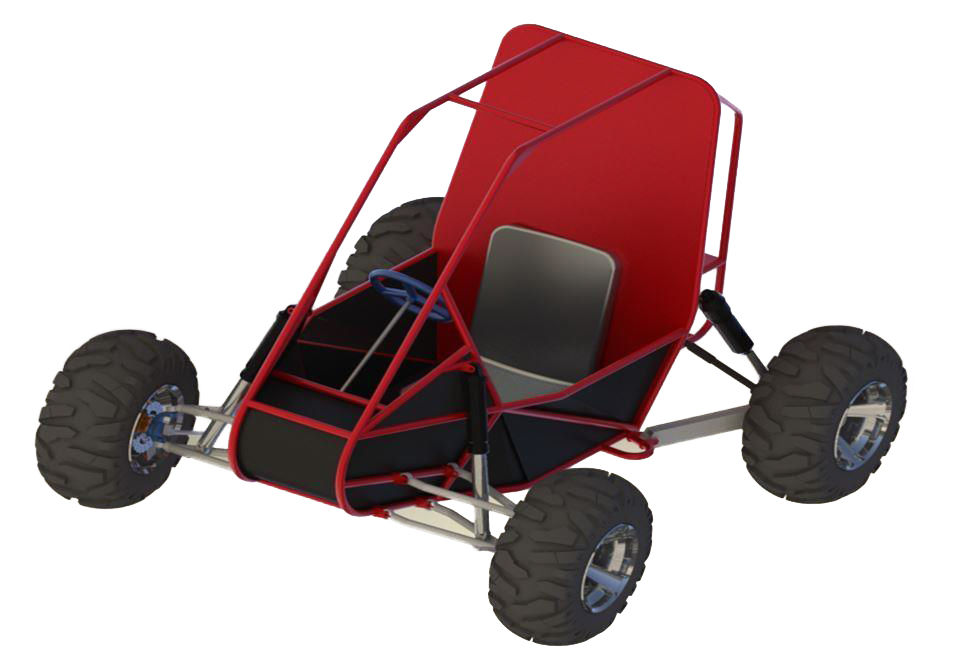About the project
To build the best BAJA Car possible to the best of our abilities and our limited budget. A car that races off-road environment is full of dirt, Oil, Grease,& high Vibrations.
This car that we made came 11th overall in India out of 200 other competitors.
Project Type : Group
Client : Extra Curricular Activities
Year : 2019
The BAJA SAE Series® is an event for the undergraduate engineering students, organized globally by the Society of Automotive Engineers, USA. The event originated in the name of Mini - BAJA, in the year 1976 at University of Carolina. Since then, the event has spanned across six countries – USA, Mexico, South Africa, Korea, Brazil and India. The BAJA SAE tasks the students to design, fabricate and validate a single seater four - wheeled off road vehicle to take part in series of events spread over a course of 3 days that test the vehicle for the sound engineering practices that have gone into it, the agility of the vehicle in terms of gradability, speed, acceleration and manoeuvrability characteristics and finally its ability to endure that back breaking durability test.
Background about the competition:


I took in effect the important points which will be combined together in wire harness

I examined the circuit beforehand and took into consideration all the possible failure cases. E.g., Malfunctioning of switches, lights, and horns. I designed contingency plans in place in case of a crash or short in the circuit itself. I designed the wire harness to be modular and be easily replaceable in the field. I used cable tags, and cable spirals at places to de-clutter and better organize the wires. The wire harness was modular to replace any faulty components quickly.
Indivisual Contribution:
Rendering of the car with CATIA v5
Being part of motorsport was always a part of a dream for me since childhood. When the opportunity presented itself, I applied to be part of my college’s BAJA team. It is a competition where students build their own All-Terrain Vehicle. I was selected in a team from a participant pool of 200 students. I was the only electronics engineer on the team.
Our ATV, "THEONE," was an amalgamation of all the best and worst ideas we could come up with. It is a testament to the amount of energy that we put into it. It was capable of tackling some pretty treacherous terrain. We faced challenges ranging from lack of time to vehicle breakdowns caused by mechanical failures or driver error.
The experience was overwhelming. We had to start from scratch and create an All-Terrain Vehicle (ATV) from scratch. The ATV needed to traverse all terrains (dirt, sand, rocks, mud, etc.) without breaking down. The vehicle was also required to have a top speed of 20 mph and carry at least two people. Furthermore, the car needed to be motorized using electric power. My role in the project was limited to electronic systems (esp. the motor controller). I had previously worked on small hobby projects like Arduino, so I was familiar with basic electronics. Participating in this competition gave me insight into how motorsport engineers work and think about their projects, creating a wire harness sport wordy. Achieving this competition forced me to work outside my comfort zone by learning new skills such as designing jigs for machining chassis pieces, designing/implementing PCBs, etc. Also, it allowed me to meet students who were passionate about motorsports.
The Story :
Photos of my work on the wiring harness

Rutvij M. Pathak , Shantanu S. Pandit , “ACCELEROMETER
BASED G -FORCE MEASUREMENT ON VARIOUS DYNAMIC COMPONENTS OF AN AUTOMOBILE WIRWELESS SENSOR NETWORK”,
IJIERT
Susceptible and accurate measurement of angular acceleration (dynamics) is essential for developing and implementing a number of modern safety-critical systems. For example, vehicle stability control systems use inputs from accelerometers to characterize the vehicle state and then to correct for undesirable rollover and oversteer modes. In such scenarios, the accuracy of the measurement is critical as it directly affects safety performance.
In this paper, we present a novel technique that uses an accelerometer-based data acquisition system to measure dynamic components directly from an automotive sensor network. The proposed method uses a combination of ADMS and conventional single-ended ADC techniques for signal conditioning and measurement. We used this data to match better our simulated design and essential components we tested in the field.